

A new 'version' of the 1965 Vatican II photograph in which Fulton Sheen and Joseph Ratzinger appear in the same photo showing the Counil's Commission on Mission at their meeting in Nemi near Castel Gandolfo to finalize their draft of the Council's document on mission The photograph features in the news item we are looking back on from July 9, 2012... [Unfortunately, the person who cropped the photo to show only Sheen and Ratzinger (and an unavoidable third person who can only be taken out of the picture by airbrushing!) committed the same mistake as the one who cropped the photo shown in the original post at the top of the post, who cropped Mons. Sheen inappropriately]
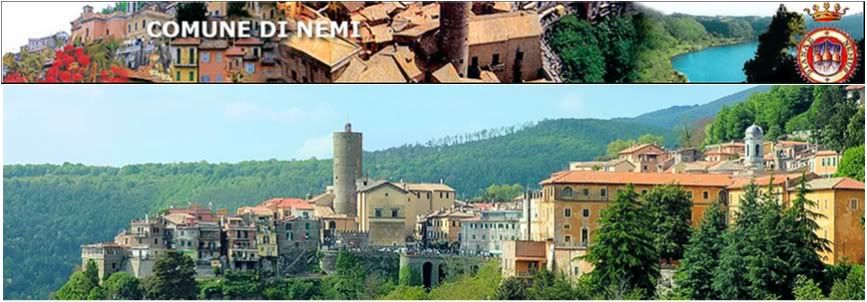
 Benedict XVI in Nemi:
Benedict XVI in Nemi:
'My most beautiful memory of Vatican-II'
Translated from

July 9, 2012
At 11:30 this morning, the Holy Father Benedict XVI left the Pontifical Villas in Castel Gandolfo by car to visit the Centro Ad Gentes of the Divine Word missionaries in nearby Nemi.
The place, then called the International Center of the Society for the Divine Word (SVD), hosted the work of the Vatican-II Commission on Mission in 1965, in which then Fr. Joseph Ratzinger took part as a theological consultant to the Council.


The Pope was greeted in Nemi by the newly-elected SVD Superior-General Fr. Heinz Kulüke, the outgoing Superior General Fr. Antonio Pernia, and the Procurator-General, Fr. Giancarlo Girardi.
At the main chapel of the Center, the Holy Father was welcomed by 150 participants in the order's annual General Chapter meeting and by the community of the diocesan Curia of Rome.
After adoration of the Blessed Sacrament, Fr. Kulüke formally welcomed the Holy Father, who went on to deliver brief remarks extemporaneously.
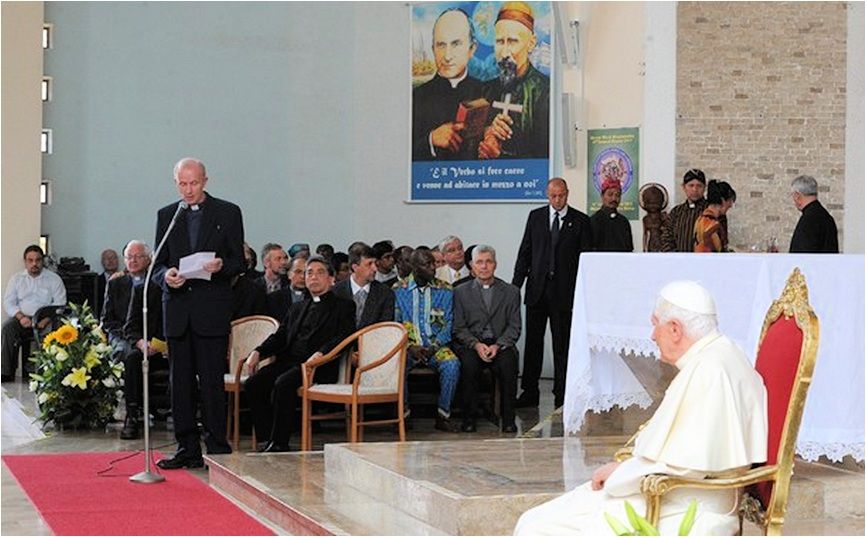
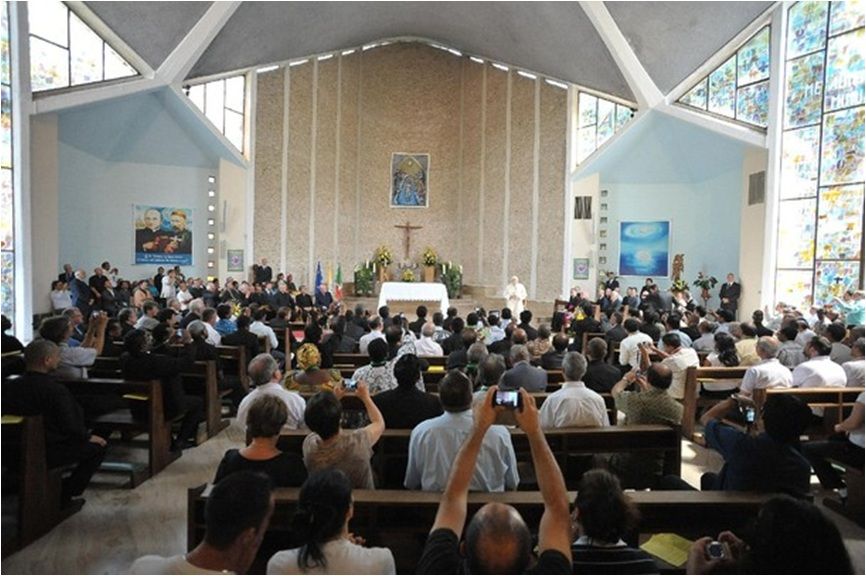 Here is a translation of the Holy Father's remarks:
Here is a translation of the Holy Father's remarks:
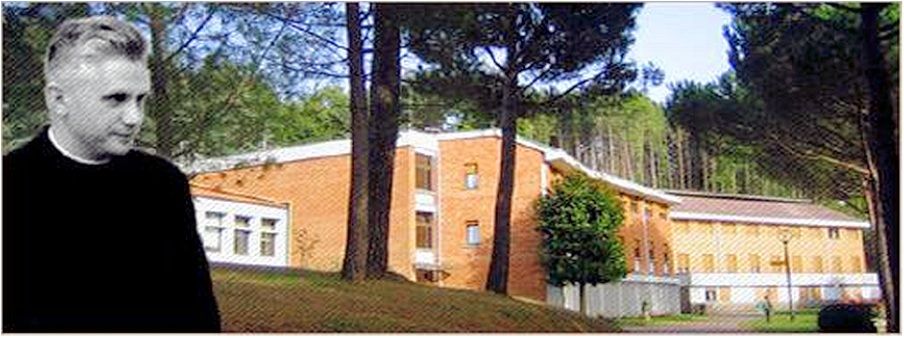 I am truly grateful for the chance to revisit, after 47 years, this center in Nemi, of which I have the most beautiful memories, perhaps the most beautiful of Vatican-II.
I am truly grateful for the chance to revisit, after 47 years, this center in Nemi, of which I have the most beautiful memories, perhaps the most beautiful of Vatican-II.
[At the time], I lived in the center of Rome, in the Collegio di Santa Maria dell’Anima, with all the noises of the city. That, too, was beautiful. But to be here, amid greenery, to have this breath of Nature and the freshness of the air, is in itself beautiful.
And then, there was the company of so many great theologians, with an assignment as important and beautiful as to prepare the Council decree on mission.
I remember, first of all, the Superior-General at the time, Fr. Schütte, who had suffered in China, was sentenced and then expelled. He was full of missionary dynamism, of the need do to give a new thrust to the missionary spirit.
And there was me, a theologian of no importance, rather young, who had been invited to take part for some reason. But it was a great gift for me.
There was Fulton Sheen, who fascinated us in the evenings with his discourses; and Father Congar and the great missiologists from Louvain. It was truly an experience of spiritual enrichment for me, a great gift.
The decree that we worked on did not involve great controversies. But there was one that I did not really understand, between the school of Louvain and the school of Muenster: What was the principal objective of mission? Was it implantatio Ecclesiae or announcing the Gospel?
But everything converged into one dynamic: the need to bring forth the light of the Word of God, the light of God's love, to the world, and to give the world new joy by this announcement.
Thus was born in those days a good and beautiful decree, which was accepted almost unanimously by the Council Fathers, and which I also consider a very good complement to Lumen gentium, because it expresses a Trinitarian ecclesiology, which starts off from the classic idea of bonum diffusivum sui - goodness has the inherent necessity to communicate itself, to give itself.
It cannot remain by itself - goodness is essentially communication. And this we already see in the Trinitarian mystery, within God himself, which is disseminated in the story of salvation and our need to give to others any goodness we have received.
It is with these memories that I think of those days in Nemi which are, for me, an essential part of my Council experience.
I am happy to see that your society is flourishing - the Father General spoke of more than 6.000 members in so many countries. Clearly, missionary dynamism is alive, and it lives as long as there is joy in the Gospel, if we stay with the experience of goodness that comes from God, which should be communicated and wants to be communicated. Thank you for this dynamism.
I wish every blessing and great inspiration from the Lord for your Chapter meeting. May the same inspiring powers of the Holy Spirit which was with us almost visibly in those days [of the Council] be present anew among you and help pave the way forward for your society as well as for the mission ad gentes in the coming years.
I thank you all. God bless you. Pray for me, as I pray for you. Thank you.
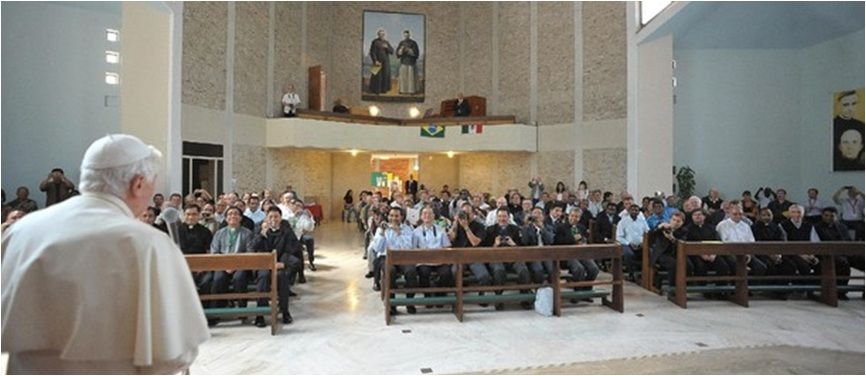
 Right, the SVD fathers show the Pope some of the photo albums and the guest register from the 1965 work session he attended. (B/W photos from tomorrow's OR).
Right, the SVD fathers show the Pope some of the photo albums and the guest register from the 1965 work session he attended. (B/W photos from tomorrow's OR).
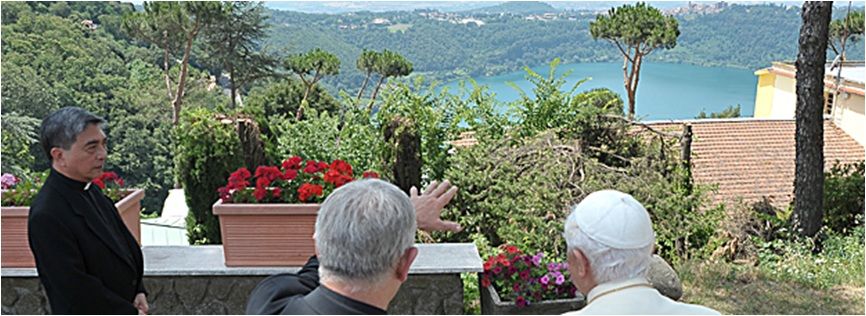 With an original photo, VATICAN INSIDER was able to do a much better blow-up from the 1965 group photo than I could from the OR photolift - too bad their photo editor appears not to have recognized the Venerable Fulton Sheen (foreground) and cropped his face in half:
With an original photo, VATICAN INSIDER was able to do a much better blow-up from the 1965 group photo than I could from the OR photolift - too bad their photo editor appears not to have recognized the Venerable Fulton Sheen (foreground) and cropped his face in half:
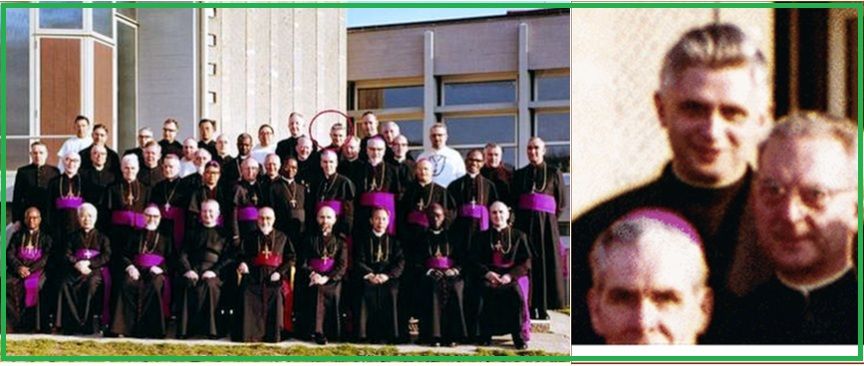 The only cardinal in the group is the commission chairman, Armenian Cardinal Gregory Agagianian (1895-1971), who was Prefect of the Congregation for the Evangelization of Peoples at the time (he had turned out to be the closest competitor to Angelo Roncalli in the 1958 Conclave). Fr. Congar is one of the four Dominicans in the photo - I think, fourth from left in the third row.
The only cardinal in the group is the commission chairman, Armenian Cardinal Gregory Agagianian (1895-1971), who was Prefect of the Congregation for the Evangelization of Peoples at the time (he had turned out to be the closest competitor to Angelo Roncalli in the 1958 Conclave). Fr. Congar is one of the four Dominicans in the photo - I think, fourth from left in the third row.
 Joseph Ratzinger revisits
Joseph Ratzinger revisits
a place associated with
his work in Vatican-II
by Alessandro Speciale
Translated from the Italian service of


VATICAN CITY - Pope Benedict XVI is visiting the international house of the Society for the Divine Word (SVD)in Nemi today, a town not far from Castel Gandolfo, which like is, is also perched above a lake in the Alban Hills south of Rome.
Since 2010, the SVD has named its meeting and retreat center in Nemi Centro Ad Gentes. Not by chance.
The center, in 1965, hosted the Vatican-II Commission on Missions which was drafting the Council decree on missions, Ad Gentes. Working with the Commission were theological consultants including Fr. Joseph Ratzinger, then 38, who returns today as Pope.
The decree
Ad Gentes – ass SVD Fr. Stephen Bevans writes in a 2009 book
Evangelization and Religious Freedom - had an 'unusually turbulent' genesis. A first version, presented to the Council at the end of 1964 and supported by Paul VI, was retracted without being brought to a vote because of opposition, such as that expressed by Fr. Ratzinger at the time.
The then Superior-General of the SVD (an missionary order generally referred to as the Verbites), Fr. Johannes Schütte, was charged with forming a commission to draft a new proposal restating the missionary task of the Church, incorporating suggestions presented by the Council Fathers. Among the experts named to work with the commission were the French Dominican theologian Yves Congar and Joseph Ratzinger.
The commission first met in Nemi in January 1965, at which preliminary meeting Fr. Ratzinger was not present. He participated in the plenary session from March 29 to April 3, when the final draft of the decree
Ad Gentes was drawn up.
When Fr. Schütte presented the draft decree to the plenary of the Council in December 1965, it was approved with 2394 votes for and only 5 against/ (This was the best voting record for any of the 16 Council documents).
The SVD center was renovated in 2010, at which time the Verbites invited the Pope to revisit them. They renewed the invitation this year on the occasion of the order's chapter-general. In the words of the SVD procurator-general, "to remember and celebrate the work" of the bishops and consultants who had prepared the decree "on retreat in this center".
In his June 9 letter to the Pope, Fr. Girardi wrote, "We would be very grateful if the Pope could;d come and bless the Center, while at the same time, the participants in the Chapter-General will have the joy of meeting the Holy Father and share some moments of filial veneration and new impetus to continue our missionary service in various local churches around the world where we are present".
Welcoming him to the center will be the newly-elected Superior General, German Fr. Heinz Kulüke. The SVD, founded in 1895 by he German priest Arnold Janssen, currently has more than 6,000 priests around the world.
[In my childhood, our parish priest was a Belgian SVD who was also the chaplain of the Catholic school I attended. The Philippines has one of the largest SVD presences in the world, with three SVD seminaries. I've always found it a bit strange that the Philippines has been considered missionary country all along - perhaps because we are a Third World country - even if we were Christianized in the 16th century and more than 80% of the population is Roman Catholic.]
The following is abridged from the original because I have omitted material already said in the preceding article....
That spring of 1965 -
and Congar's diary notes
by Gianni Valente
Adapted and translated from the Italian service of

"What a place! Everything is very fine: marble and decorative wood...", Dominican Fr. Yves Congar wrote about the SVD center in his Vatican-II diary published posthumously only a few years ago.
The excellent hospitality offered by the SVD when Congar was part of the Vatican II commission which met in Nemi twice to draft the conciliar decree Ad Gentes was noted with ascetic embarrassment by Congar: "A table that is a bit too abundant. Not just that there isn't anything Lenten about it [the second session took place during Lent], but there was a true excess of everything. In the evenings, meals were taken with wine. Obviously, this all helps create an atmosphere of cordiality, and that is why Fr. Schütte does it, but at what expense!"
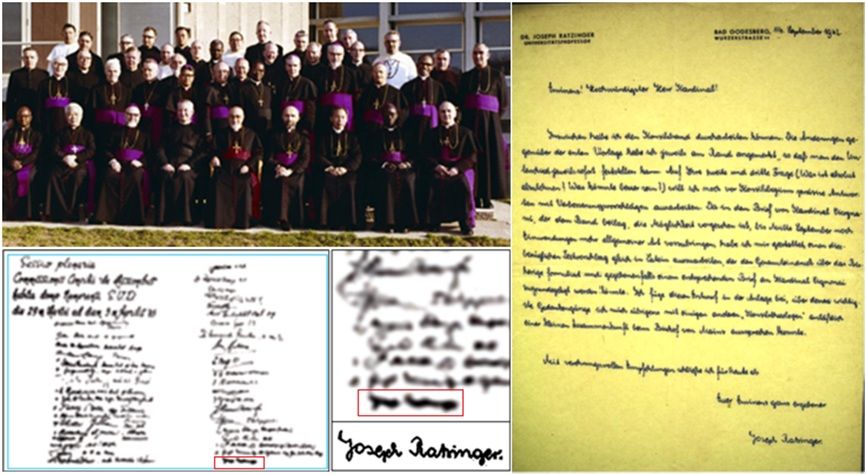 The OR published the group photo of the Ad Gentes commission seen above, with the signatures of the participants on the Center's register, which unfortunately does not reproduce very well. Joseph Ratzinger's is the last signature, and since it does not enlarge well at all, I used a similar signature from a 1962 document for comparison (a letter written in September 1962 by Fr. Ratzinger to Cardinal Frings reporting on what he had done by way of preimianry work for their pwrticipation in Vatican-II*.
The OR published the group photo of the Ad Gentes commission seen above, with the signatures of the participants on the Center's register, which unfortunately does not reproduce very well. Joseph Ratzinger's is the last signature, and since it does not enlarge well at all, I used a similar signature from a 1962 document for comparison (a letter written in September 1962 by Fr. Ratzinger to Cardinal Frings reporting on what he had done by way of preimianry work for their pwrticipation in Vatican-II*.
The Pope's visit will doubtless bring back memories of the brainstorming sessions on the great themes concerning the life of the Church in which he took part as a theological consultant during the years 1962-1965.
[He first came to Vatican II as a consultant for the Archbishop of Cologne, Josef Frings, who immediately got him appointed as an official theological expert (peritus) for the Council itself.]
Cardinal Frings, with arguments put together by Fr. Ratzinger, had been one of the leaders in the successful move to withdraw the draft decree on missions prepared by the Vatican-II Preparatory Commission.
Although Fr. Ratzinger was not present at the first meeting of the commission on the missions decree in Nemi, an important text in the working agenda was his paper on the theological foundation of Church missions, «Considerationes quoad fundamentum theologicum missionis Ecclesiae»".
The Latin paper, recently published in the magazine of the Vatican-II study center of the Pontifical Lateran University, is dedicated to the doctrinal principles of mission, and offers relevant points of reflection even today, in view of the coming Synodal Assembly on the New Evangelization and the Year of Faith.
In 1965, Fr. Ratzinger wrote authoritatively that mission "is not a battle to capture other people in order to incorporate them into our own group". He sees mission not as self-actuated by the Church, but that Christ himself through the Church, draws to him and the Father the hearts of men. "No human or religious effort in themselves can save men - all salvation comes from Christ".
The work session in Nemi confirmed the affinity and similar outlook between the Bavarian priest and the French theologian Congar, twenty years his senior.
They both rejected the narrow idea of mission which was limited to the traditional idea of bringing the Gospel to pagans. They thought that this reduced everything to technical and jurisdictional problems regarding the formation of new dioceses in mission lands.
The two theologians believed in a unitary perception of mission and its theological sources and then applying it to concrete contexts and circumstances.
Congar, in his Council diary, famously gave way to his feelings even about those with whom he worked (and whom he named openly). "Fr. X is truly an ass", or "Mons. Y says nothing and seems very bored", or "Mons. Z almost does not follow [the discussion] and is of no help at all".
He makes one exception: "Fortunately, there is Ratzinger. He is reasonable, modest, dispassionate, and very helpful", he says in his notes for March 31, 1965.
[My addendum: The second of the three great French theologians who served as periti at Vatican-II, Henri de Lubac, also made observations in his Vatican-II diaries about those he encountered. He said of Joseph Raztinger that 'his powerful intellect is matched by his peacefulness and affability', and of Hans Kueng, that he had 'juvenile audacity' and was 'incendiary, superficial and polemical' in his speech.
All three French periti were made cardinals eventually: Yves Congar (1904-1995) in 1994, Henri de Lubac, SJ (1896-1991) in 1983, and Jean Danielou, SJ (1905-1974) in 1969. Paul VI would also have made de Lubac cardinal in 1969, but he declined at the time because it was required then that a cardinal must be made bishop first. John Paul II waived the requirement for him in 1983. The only other Vatican II peritus to be made cardinal was Joseph Ratzinger in 1977, whom Paul VI elevated at age 50 because of his theological work, well before his mentors De Lubac and Congar. The three French theologians were recognized but at a much older age. I checked and saw that Cardinals Walter Kasper and Kurt Lehmann were both made cardinals in 2001, at age 68 and 65, respectively, but although both are theologians, they became cardinals by virtue of the positions they held at the time- Kasper as President of the Pontifical Council for Promoting Christian Unity, Lehmann as chairman of the German bishops' conference.]
 2019 P.S. 1) I am surprised, in hindsight, that Mons. Lefebvre was not in the V-2 Commission on Mission, since he was a missionary in Africa from 1932-1962, ending up as Vicar Apostolic of Dakar, Senegal, and the next year as the Apostolic Delegate for West Africa.
2019 P.S. 1) I am surprised, in hindsight, that Mons. Lefebvre was not in the V-2 Commission on Mission, since he was a missionary in Africa from 1932-1962, ending up as Vicar Apostolic of Dakar, Senegal, and the next year as the Apostolic Delegate for West Africa.
2) How many participants in Vatican II - Council Fathers and their periti or theological consultants - have been sainted so far, or even had the process started? None, I think. I do not count John XXIII, Paul VI and John Paul II, because of the ideological considerations that have 'tarnished' their canonizations [And I think it is just awful that John Paul II, the only one of the three who had a public cult for holiness ('Santo subito', remember), ended up being 'paired' for canonization with John XXIII, for whom the reigning pope waived the requirement of a canonization miracle just so he could be sainted at the same time as JP-II. I do not think John XXIII could have looked down with favor upon the exception made in his case - as if he could not be expected to bring about a second miracle! About Paul VI's canonization, the less said about it, the better.
It surely cannot be right to cheapen the canonization process by giving special consideration to popes and accelerating their sainthood iter. A general degradation, if not outright travesty, of the church's canonization process that has now led to Bergoglio beatifying his Satanellis as martyrs for dying in a car accident, or something equally absurd.
[Modificato da TERESA BENEDETTA 08/05/2019 20:32]